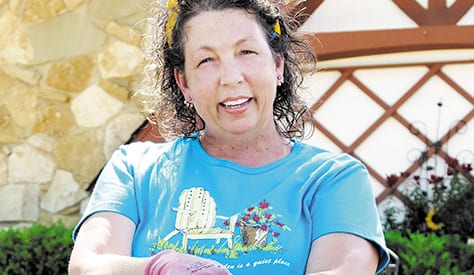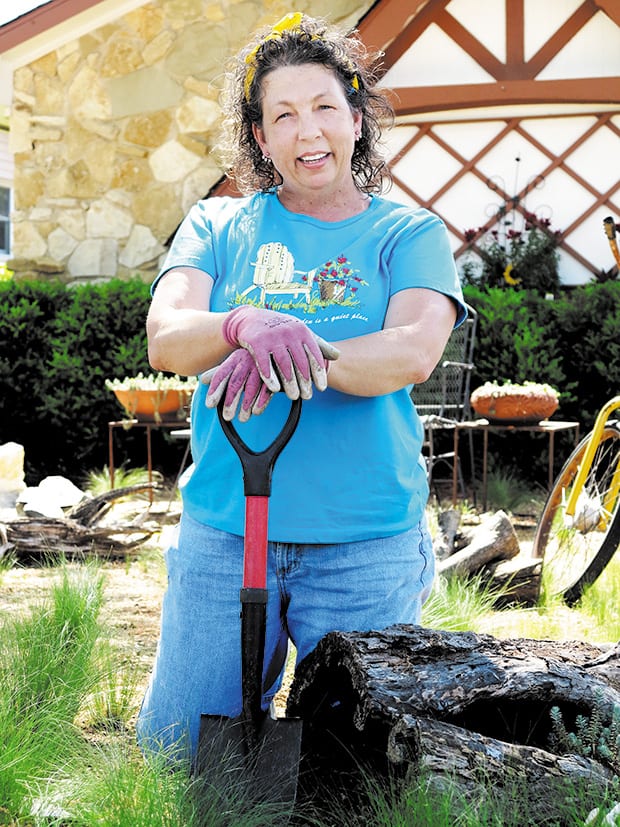Plant whisperer Kato Crow dishes the (composted) dirt on gardening in North Texas
A month into spring, you and your lawn are waking up from winter funk. Time now to dig into reviving your greenery. We asked certified nursery professional and self-described “Dallas plant geek” Kato Crow for her best tips for making your garden grow.
For lusher lawns
Dress it up. Dallas soil gets depleted every two to three years. Whether your lawn is St. Augustine grass, Bermuda, Zoysia or a mix, you should “top dress” it with a half-inch of organic compost every few years. Intense heat from summer sun bakes away good organic matter and heavy rain washes it away. (August 2016 was the wettest in 100 years, Crow says.) April is the best time to feed a lawn with compost; don’t do it in the heat of the summer.
 Grounds for your ground. Look closely for places in your lawn where water has pooled over the winter or where there’s evidence of root rot or soil depletion. Those bald spots along the edges of sidewalks, driveways and plant borders would love a jolt of java from your leftover coffee grounds, whose acidity counteracts our soil’s alkalinity. (Sprinkle it like fairy dust, says Crow; don’t dump it in globs.)
Grounds for your ground. Look closely for places in your lawn where water has pooled over the winter or where there’s evidence of root rot or soil depletion. Those bald spots along the edges of sidewalks, driveways and plant borders would love a jolt of java from your leftover coffee grounds, whose acidity counteracts our soil’s alkalinity. (Sprinkle it like fairy dust, says Crow; don’t dump it in globs.)
Get tricky. If you have azaleas, camellias, gardenias, Japanese maples, dogwoods or hydrangeas in your yard, you need to “trick them into liking Dallas” by amending the soil with special mixes (ask at your neighborhood garden center) and top-dressing with acid fertilizer three times a year (Easter, Memorial Day and Labor Day are good times for that). Root balls of those flowering shrubs need acid to produce blooms.
Try some trees. The best time to plant a tree is 20 years ago, Crow advises. The second-best time is today. (Talk to a garden professional about the best choices for your area.) Plan for the mature size of a tree or shrub so they don’t crowd out in three years. “The first year they sleep; the second year they creep; and the third year they leap!”
Pooches need paths. If you have dogs who run around the perimeter of your yard, place landscaping 18 to 24 inches away from fences so the pups have a pathway. “My daughter and her wife have three dogs, so they keep most of their flowers and herbs in sturdy pots to avoid trampling,” Crow says. “Also, scoop the poop and discard it. Don’t add it to your compost pile.”
For gorgeous gardens
Compost the most. “Whoever has the most organic compost wins,” Crow notes. You can be an active composter or a lazy one. (The city of Dallas even offers free composting classes.) Create good compost material with either a “batch composter” in a barrel or a flat composter inside a 3×3-foot grid outdoors. Compost needs carbon (dryer lint, hairbrush hair, pet hair), nitrogen (potato scraps, grass clippings) and moisture (about the consistency of a squeezed-out dishrag) to “cook” for about six to eight weeks. Don’t ever compost pet waste (cat or dog), because of bacteria.
Plant now, eat later. Now is the perfect time to plant a vegetable garden. “Our hard season isn’t winter, it’s summer,” says Crow, so planting in April allows roots to form and establish before those 100-degree days roll around. You can garden 12 months a year in North Texas, with cabbage, kale, broccoli, cilantro and Brussels sprouts continuing to produce well through the winter. Try “edible landscaping” with pomegranate, plum and fig trees, which are self-fertilizing and “Texas tough,” Crow says.
Herbs work. Dallas gardens love evergreen herbs like rosemary, thyme, oregano and sage, which are low-maintenance, tasty and look pretty in gardens or containers. “Find out what you grow well,” Crow advises, “and grow a lot of it.”
For perkier potted plants
Plant a thriller, a spiller and a filler. Don’t just plant one thing in a pot; plant three. Crow counsels filling pots in a peace symbol or bullseye pattern with a tall “thriller” plant in the center, ringed by a medium-high “filler” and then a low “spiller” around the edges. Reliable “thrillers” are Cordylines (a showy purple-pink palm) and tropical hibiscus. “Fillers” could be petunias or begonias, which Crow says are “tough as hell.” And good “spillers” are trailing herbs such as oregano or rosemary, or the old-fashioned, reliable sweet potato vine.
Let them drink, not drown. People water too much, Crow says. Allow the top 2-in. of pot soil to dry out between thorough waterings. Watering too often (i.e., every day) can lead to suffocation and root rot. “When water goes in, air comes out. We’re trying to find a happy medium between a drink of water and drowning.” Cover the drain holes in your planter boxes and plant pots with a coffee filter before you add rocks or broken pot pieces for drainage to keep soil from dirtying up the patio or creating a plug in the container.
Try some “funky shui” planters. Think beyond those gardening center plastic or ceramic pots. Crow says she’s put potted plants into old dresser drawers, worn-out cowboy boots and other found objects. “Use whatever you like as long as it has a drain hole.”
Put plants in the best light. Some plant pot tags will say “full sun,” but those tags were printed in Utah, not Texas, Crow says. “Do a ‘sun audit’ with your camera phone,” she advises. Go stand where your plants are at noon and look up. If you see sky, it’s full sun. If you see a tree, it’s a shady spot. Move plants around to the right light.
It’s not a chore; it’s a natural workout. “You can bury a lot of troubles digging in dirt,” says Crow. “Gardens reduce stress and are an excellent way to exercise with all that lifting, digging and bending.”
— Elaine Liner
Kato Crow offers gardening classes and workshops and will come to your house for a one-hour “horticultural house-call.” DFWPlantWhisperer.com.
This article appeared in the Dallas Voice print edition April 21, 2017.














Where did you live in Iowa?